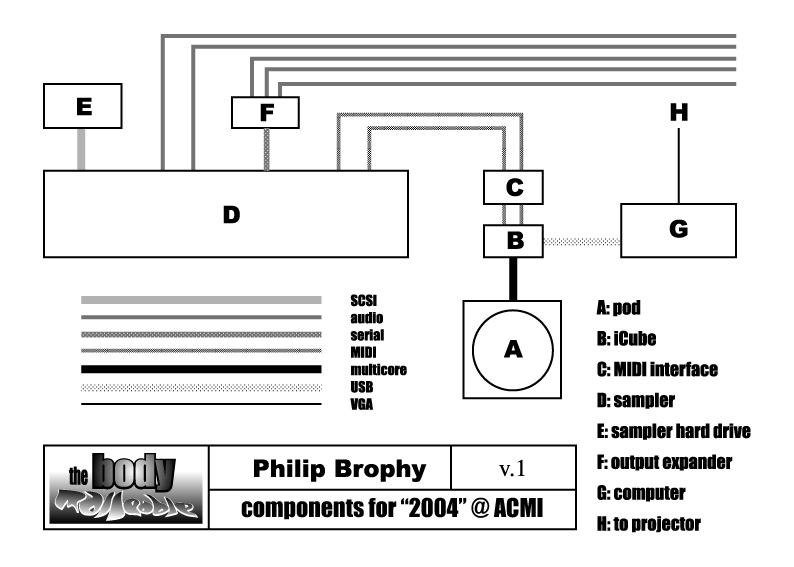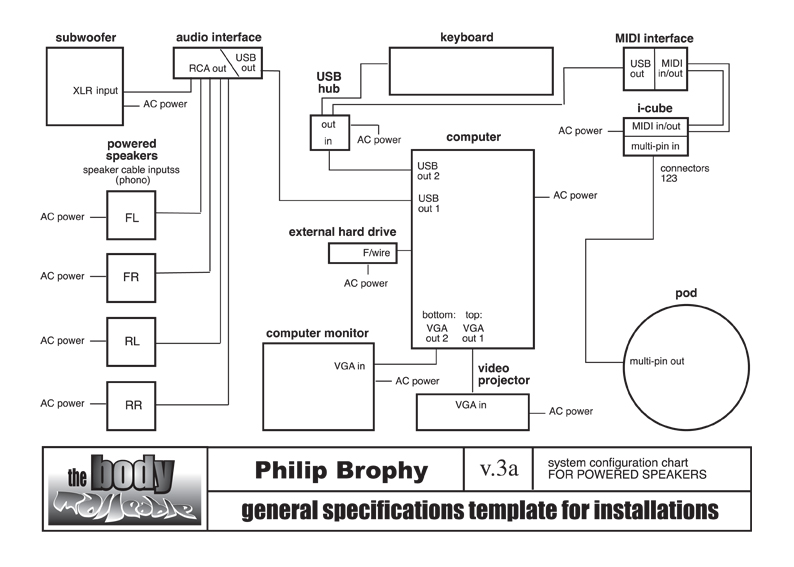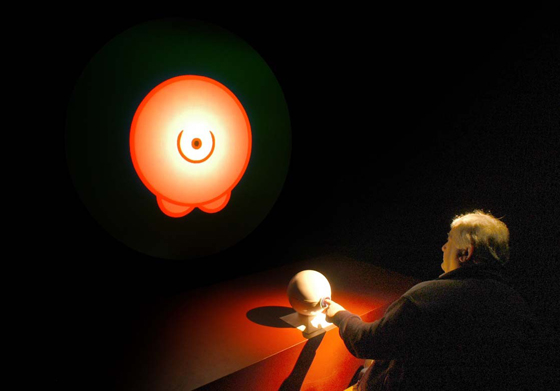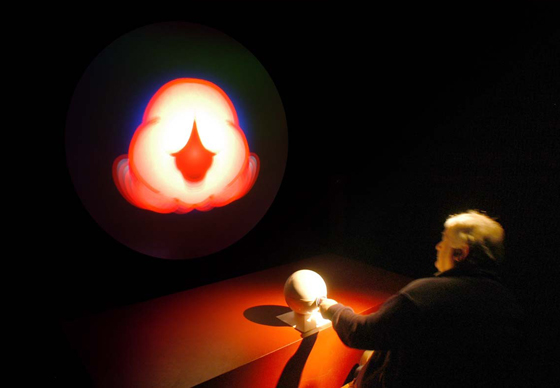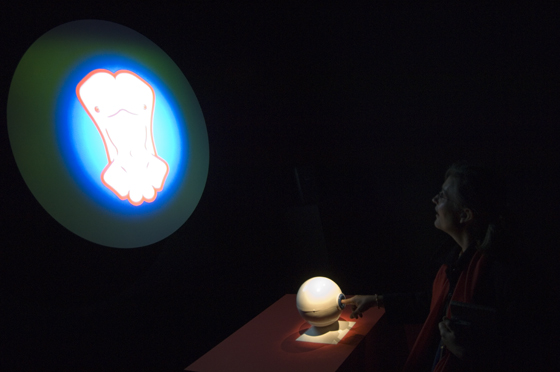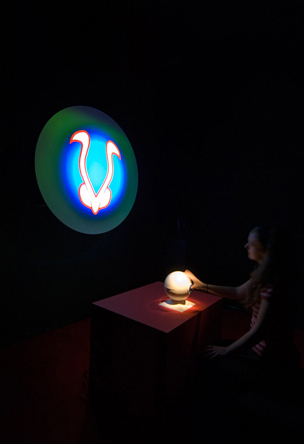Background
The Body Malleable is a small-scale interactive work comprised of digital animation projected into a private darkened space. The user controls the animation and its synchronized audio via a custom-built physical interface.
The Body Malleable was commissioned by the Cinemedia Digital Media Fund in 2002. The invitation was to produce an interactive for the Australian Centre for the Moving Image's permanent collection. The submitted proposal was to produce an interactive that would minimize anything to do with foregrounding interactive media and maximize experience. The aim was particularly concerned with delivering content that did not make a broad statement about interactivity.
The Body Malleable is conceptually shaped by Philip's established themes (bodies, sound, sex, etc.) and is focused on the 'digital penetration' of a single finger. The interactive took the form of a pod ball (about the size of a soccer ball) with a small opening. Placed on a table in front of a suspended screen, the participant sticks their finger into the hole to move through a series of animated images on the screen. 4-channel surround sound accompanies the imagery. Both sound and imagery are wholly controlled by the participant's finger action. The animated images comprise a series of morphing possibilities of body parts, orifices, protrusions and organs. The synchronized soundtrack is constructed from digitally-processed fragments of human vocals.
Credits
Concept & direction: Philip Brophy
Sound design: Philip Brophy
MIDI implementation: Casey Rice
2004
Premiere exhibition - 2004: AUSTRALIAN CULTURE NOW - Australian Centre for the Moving Image, Melbourne
Overview
The complete animation of The Body Malleable is comprised of 16 image sequences, each divided into 2 halves. These sequences contain between 35 to 70 individual frames. The first half of a sequence plays when the user inserts their finger. Then when the user pushes the soft silicon wall at the end of the colon, the second half of a sequence imperceptibly switches over until the user brings his/her finger back toward the opening of the orifice. Then at that point the first half of the next sequence is imperceptibly triggered. The sound design required frame synching to the complete 'malleability' of this movement by the user. At the project's conception, composer Philip Brophy decided that all audio had to be controlled by MIDI, and not simply trigger a set of pre-defined and unalterable fragments of digitized audio as is the case with many interactives.
Technical
Sound Design
A skeletal approach was initially defined for the dynamics of movement inherent in each sequence of 8 key-frames as indicated in the accompanying design sequence. This involved:
1. establishing a dramatically increasing set of ‘bed tones’ to match the overall forward momentum as the user moves through all 16 sections (numbered A to P);
2. articulating a sonic texture to represent the current state of the body-form for each of the 2-part divisions (numbered 1-4, 5-8) within each of the 16 sections;
3. specifying a set of ‘tension’ and ‘rest’ aspects to sonically illustrate the movement and transformation of the body frame within each 2-part division of the 16 sections.
An ASR sampler was chosen as the stand-alone proprietary system for generating the audio, leaving the computer and MAX to handle the image frame-movement, pixel-resolution and screen-refresh-rate. In keeping with the tactile/visceral aspects of The Body Malleable, the audio was comprised of samples of vocalized effects and gestures by Philip Brophy, which were then waveform edited into quadraphonic layers.
Once Casey had settled on the best way to code in MAX the means by which he could have the fader movement match the differing frame sequences of animation, he then required a series of ‘hit spots’ where MIDI note information would be sent to the sampler to move to each successive sample or sound. To provide this information, a complete chart had to be constructed specifying the exact frames in each of the 32 image sequences where note-change events would occur. A total of 129 'hot spots' were identified in the animation, where a visible point of transformation occurred which required a synchronous shift, transposition or new event in the audio.
This required extensive modifications mainly due to the way the sounds appeared when the Physical Interface’s fader would scrub back and forth. Aspects of the originally designed sounds in the sample library had to be modified so that they sounded engaging when only half sounded due to the fader being stopped half-way through its movement. Some clipping occurred also as samples looped in millisecond bites. All these problems were eventually resolved. A sample of the final sound design chart for the first 4 sequences (containing 37 'hit spots') is as follows:
Sequence A1
1 main ball at rest
18 small central orb forming
32 full small orb forms
47 dual orbs form
53 dual orbs rest @ circumference
Sequence A2
43 dual orbs start rotation
33 dual orbs touch top/bottom
13 dual orbs touch top/bottom
1 dual orbs disappear
Sequence B1
1 main ball at rest
18 small central orb forming
31 full small orb forms
47 dual orbs form
53 dual orbs @ rest
Sequence B2
30 dual orbs start descent
24 central orb forms
1 dual orbs rest low + central orb complete & @ rest
Sequence C1
1 dual orbs recede
10 dual orbs now leg-stumps behind + penile head stretches forward
20 penile shaft pushes upwards
53 penile shaft extended upright
Sequence C2
61 penile shaft starts bending left
37 penile shaft starts flop downwards
24 penile shaft swings past bottom
14 penile shaft rests at top + penile shaft lightly flops left/right
1 penile shaft rests extended upright
Sequence D1
1 penile shaft contracts downwards
14 penile shaft rests at top + penile shaft lightly flops left/right
24 penile shaft recedes inwards slightly
35 penile head rests centrally
37 penile shaft starts flop downwards
61 penile shaft starts bending left
Sequence D2
54 penile head deflates centrally + rear leg stumps separate
39 rear leg stumps become rounded and move up
33 penile head shrinks
21 hole forming in shrink-fading penile head + stump-orbs at extreme left/right sides + stems start growing
1 penile hole alone left in centre + 1 reduced orbs rest at top-sides + 1 stems rest fully protruded

